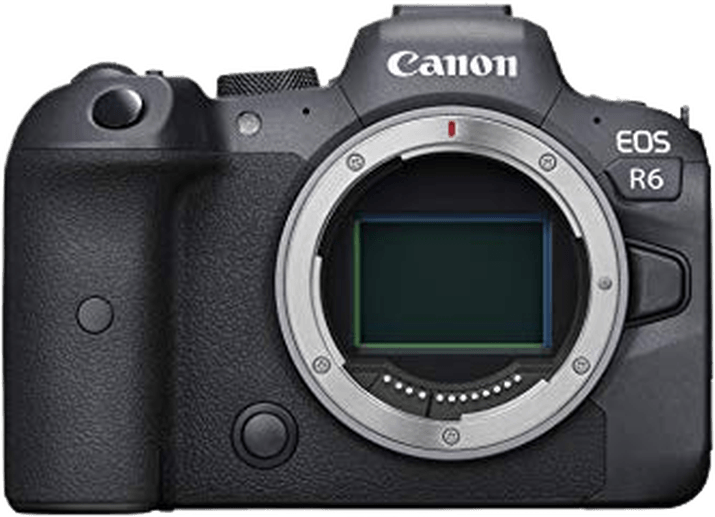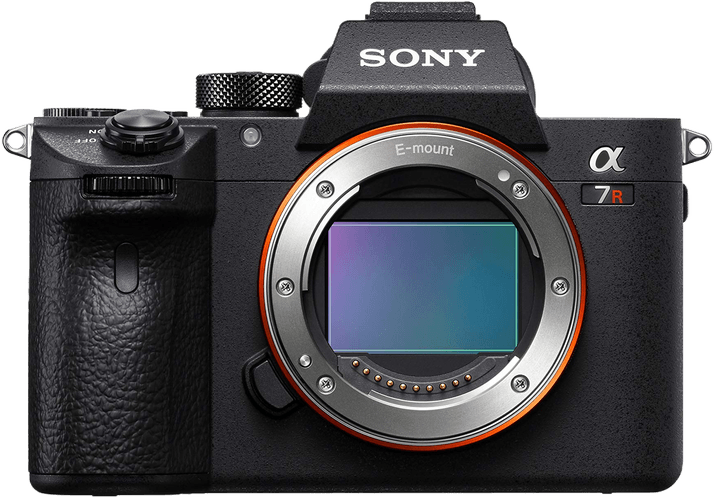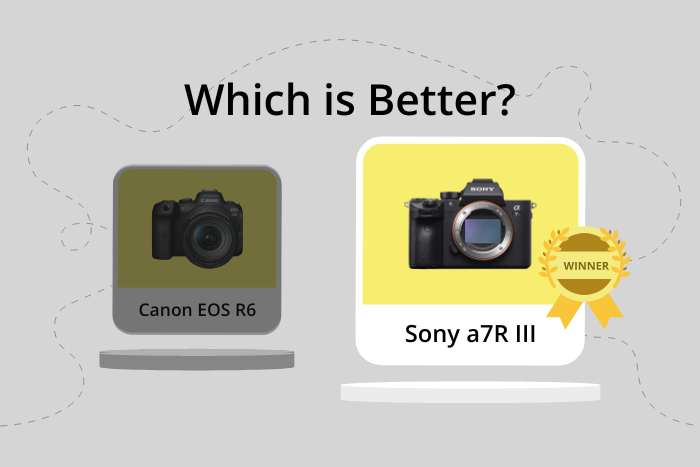Canon EOS R6 vs Sony a7R III Comparison
Canon EOS R6

Sony a7R III

The Sony a7R III outperforms the Canon EOS R6 with a score of 83/100 compared to 80/100. Both cameras share some common specifications, such as being mirrorless and having similar dimensions and weight. The Sony a7R III excels with its higher score, despite being released in 2017 and having a higher launch price of $3200. On the other hand, the Canon EOS R6, released in 2020, is a more affordable option at $2499.
Although the Sony a7R III has a higher score, the Canon EOS R6 might be a better choice for some users due to its lower price and newer release date. However, the Sony a7R III remains a strong competitor with its superior performance. Ultimately, the choice depends on individual preferences and budget considerations.
Canon EOS R6 vs Sony a7R III Overview and Optics
The Sony a7R III wins the optics comparison with a score of 84/100, while the Canon EOS R6 scores 79/100. Both cameras share some common specifications: they have CMOS sensors, full-frame sensor sizes, and offer image stabilization. Additionally, both cameras use their respective brands’ lens mounts – Canon RF for the EOS R6 and Sony FE for the a7R III.
The Sony a7R III outperforms the Canon EOS R6 in several aspects. The a7R III has a higher megapixel count at 42.4, compared to the R6’s 20.1, providing greater detail and resolution in images. The a7R III also has a higher DXOMARK sensor score of 100, which means it delivers better image quality, especially in low-light conditions. The Bionz X processor in the Sony a7R III also contributes to the overall performance of the camera.
On the other hand, the Canon EOS R6 has its advantages. The R6 offers a faster shooting speed of 20 frames per second, compared to the a7R III’s 10. This makes the R6 more suitable for capturing fast-moving subjects or action photography. The Digic X processor in the R6 also ensures fast and efficient processing of images.
Taking these factors into account, the Sony a7R III is the better choice for photographers who prioritize image quality and resolution. The higher megapixel count and superior DXOMARK sensor score make it an excellent option for landscape, portrait, and low-light photography. However, the Canon EOS R6 is a strong contender for those who require faster shooting speeds for action and sports photography. Ultimately, the decision between these two cameras depends on the specific needs and preferences of the photographer.
Canon EOS R6 vs Sony a7R III Video Performance
The Canon EOS R6 outperforms the Sony a7R III in video capabilities with a score of 91/100 compared to the latter’s 56/100. Both cameras share 4K as their maximum video resolution and have the same maximum video dimensions of 3840 x 2160. However, the similarities end there, as the Canon EOS R6 offers superior features.
The Canon EOS R6 boasts a maximum video frame rate of 120fps, significantly higher than the Sony a7R III’s 30fps. This allows the R6 to capture smoother and more detailed slow-motion footage, making it a better choice for videographers who require this feature. Additionally, the R6 has built-in time-lapse functionality, which the a7R III lacks. This means that the R6 users can create stunning time-lapse videos without needing extra equipment or software.
On the other hand, the Sony a7R III does not have any clear advantages in video capabilities over the Canon EOS R6. Its lower video score and fewer features make it less appealing for those who prioritize video performance.
Taking all of this into consideration, the Canon EOS R6 clearly outshines the Sony a7R III in terms of video capabilities. Its higher video score of 91/100, faster frame rate, and built-in time-lapse functionality make it the superior choice for videographers and filmmakers. Meanwhile, the Sony a7R III, with its lower video score and lack of standout features, may not be the best option for those who value video performance in their cameras.
Canon EOS R6 vs Sony a7R III Features and Benefits
The Canon EOS R6 takes the lead in features with a score of 85/100, while the Sony a7R III trails slightly behind at 83/100. Both cameras share several specifications, including a 3-inch screen size, touchscreen capability, flip screen, and the absence of GPS. They also both offer Wi-Fi and Bluetooth connectivity.
The Canon EOS R6 stands out with its superior screen resolution of 1,620,000 dots, compared to the Sony a7R III’s 1,440,000 dots. This higher resolution provides a clearer and sharper image display, enhancing the user’s experience when framing shots, reviewing images, and navigating menus.
On the other hand, the Sony a7R III still holds its ground with its strong feature set, only falling short by two points in the overall comparison. While it might not have the same screen resolution as the Canon EOS R6, it maintains its competitiveness by offering similar features and connectivity options.
Taking into account the common specifications and the slight edge the Canon EOS R6 has in screen resolution, it is the winner in the features category. However, the Sony a7R III remains a strong contender and should not be overlooked. Both cameras provide a range of useful features and connectivity options, making them suitable for various photography needs. Ultimately, the choice between these two cameras will depend on individual preferences and requirements.
Canon EOS R6 vs Sony a7R III Storage and Battery
The Canon EOS R6 edges out the Sony a7R III in storage and battery performance with a score of 68/100 compared to Sony’s 65/100. Both cameras possess two memory card slots and accept SD, SDHC, and SDXC cards with UHS-II compatibility.
The EOS R6 surpasses the a7R III with its USB charging capability, providing convenience for on-the-go photographers. However, the a7R III outperforms the EOS R6 in battery life, delivering 650 shots per charge compared to the EOS R6’s 360 shots. The a7R III utilizes the NP-FZ100 battery type, while the EOS R6 uses the LP-E6NH battery.
Despite the longer battery life of the Sony a7R III, the Canon EOS R6’s USB charging option makes it a more practical choice for photographers who prioritize flexibility and ease of charging.
Canon EOS R6 vs Sony a7R III Alternatives
Still not sure which camera is right for you? We have a recent article explaining Canon camera names and types which could be useful. These trending camera comparisons may inspire you:

